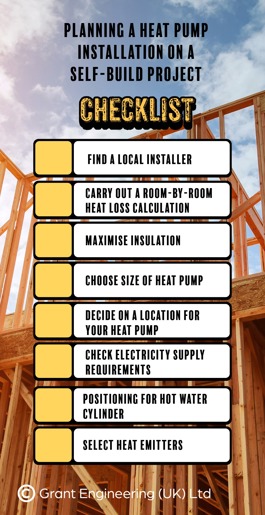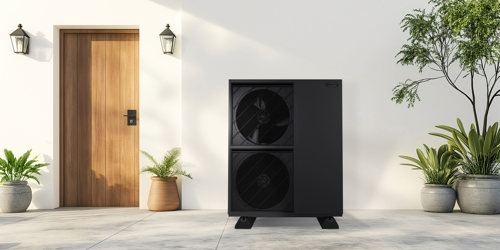If you are a self-builder planning the exciting build of your next home, choosing the right heating system for your property will be an important decision and a key element of the build project. Read our guide for self-builds which focuses on why a heat pump could be the perfect solution for your heating and hot water, and what you need to know about this low-carbon heating system.
Products
Knowledge & Support
Explore our Knowledge Hub:
Tips & Advice Education Area Case Studies The Grant House Virtual House FAQs Glossary Visit the Knowledge HubLooking for Help & Support:
Product Support Find an Installer Find a Merchant Extended Warranties ServicePlan Product GuaranteesProducts
Knowledge & Support
Explore our Knowledge Hub:
Tips & Advice Education Area Case Studies The Grant House Virtual House FAQs Glossary Visit the Knowledge HubLooking for Help & Support:
Product Support Find an Installer Find a Merchant Extended Warranties ServicePlan Product GuaranteesChoosing a heat pump – a guide for self-builders
|
Building your home is a project that is exciting but it can also be daunting. A self-build can take years of planning and preparation from initial designs and planning permission through to the build phase and completion. One aspect of a self-build development which should never be underestimated is the selection of a heating system. The good news is air source heat pumps can be the best heating for new builds, providing you with a low-carbon, efficient and reliable heat source for your new home.
In this blog, we share a self-builders guide to heat pumps by covering:
- How heat pumps heat self-build homes
- The regulations that self-builders need to be aware of when it comes to heating systems
- The steps involved in planning and specifying a heat pump for a self-build
- Funding available to self-builders for air source heat pumps.
How does a heat pump heat a self-build home?
An air source heat pump warms up a property by extracting the heat energy from the air outside and converting this into usable energy which can be transferred through a wet central heating system as follows:
1. The outside air is drawn into the heat pump where the heat energy from the air is extracted using a refrigerant (such as R290 or R32)
2. This heat is then transferred into the water of the heating system
3. The system water leaves the heat pump, transporting the heat energy to underfloor heating and/or radiators to provide space heating to rooms
4. The heat energy is also used to warm up the water stored in a separate cylinder which can then be used in taps, showers and baths.

It is worth noting that there are different types of heat pumps available, principally air source heat pumps (including air-to-water heat pumps and air-to-air heat pumps) and ground source heat pumps. We are focusing on air source heat pumps and specifically how air-to-water units can fulfil the heating demands of a self-build home.
We go into more detail about how air-to-water heat pumps work in the Education Area of our Knowledge Hub.
Regulations for self-build heating systems
When it comes to building a new home, self-build and custom housebuilders must adhere to the Self-build and Custom Housebuilding Act 2015 as well as complying with the standards set by Building Regulations. The Approved Document L (Conservation of fuel and power) (Part L Building Regulations) covers the building regulations in England, setting minimum standards for the energy performance of new (and existing) buildings. New dwellings must achieve a target primary energy rate, a target emission rate and a target fabric energy efficiency rate and evidence of meeting these targets must be provided via appropriate calculations. All three of these ratings will be influenced by the selection of fabrics used to construct a property with the choice of fuel used to heat a property influencing the primary energy rate and emission rate.
What type of heat source you choose can therefore determine whether or not you fulfil the requirements set by these new build heating regulations. Choosing a low-carbon air source heat pump can help your self-build home achieve these standards.
Part L Building Regulations also stipulate that buildings should be designed in a way to conserve the use of fuel and power by:
- limiting heat gains and losses (through thermal elements of the building fabric as well as from pipes and vessels used for heating, cooling and hot water)
- ensuring fixed building services are energy efficient, have effective controls and are commissioned to test they are working as effectively and efficiently as possible.
When designing your property, it is important that the fabric efficiency of the materials you choose for walls, floors, roof, windows and openings meet the standards set out by Part L Building Regulations. Furthermore, by meeting these regulations to minimise heat loss from your home, you will be creating a property which will be perfectly suited to a low-temperature heat pump heating system.
Self-builders should be aware of the Future Homes Standard which are due to be introduced by the Government imminently. The Future Homes Standard will implement changes in legislation which will impact the Part L Building Regulations, setting new requirements which fossil fuel heating systems will not meet and thus meaning that low-carbon heating systems will be mandatory for new dwellings.
What are the benefits of a heat pump for a self-build?
There are many advantages of a heat pump. For self-build and custom homes, heat pumps have lots of benefits including:
- Your home will not be reliant on fossil fuels – by installing an air source heat pump, your home will be kept warm using renewable energy which will mean you are not dependent on fossil fuels and you will not have fossil fuel energy bills, gas for example.
- A heat pump is an incredibly efficient heating solution – when a heat pump system is correctly designed, installed and commissioned, it can operate very efficiently. Grant heat pumps have excellent Seasonal Co-efficient of Performance (SCOP) values ranging from 4.56 to 5.40 (at 35º water flow temperature).
- Enjoy an energy efficient home – by designing your property to complement a heat pump’s operation, with excellent levels of insulation and minimum amounts of heat loss, your home will be an energy efficient building. This could add value to the property’s resale in the future as energy efficient homes with better SAP ratings are often more desirable.
- Air source heat pumps are straightforward to maintain – looking after a heat pump system involves minimal maintenance. This typically includes annual servicing which will be carried out by your heat pump engineer and regularly doing visual checks to ensure no leaves or debris are covering the unit. Visit our blog to learn more about looking after an air source heat pump and visit our YouTube Channel.
Planning a heat pump installation for a self-build
A heat pump installation comprises of four key stages – design and system specification, installation, set-up and commissioning, and customer handover which will involve your installer talking you through how your system operates.

Here are some of the important steps that self-builders will need to complete as part of their heat pump installation:
- Find a local heat pump installer – to install your heating system, you should choose a suitably qualified installer who is heat pump trained and confident with renewables. Your installer will be able to advise on the different types of system available for you, such as open loop, and discuss the benefits it could deliver. To find a local Grant UK G1 Heat Pump Installer, please use our Find an Installer online search tool.
- Carry out room-by-room heat loss calculation – this calculation will need to be carried out using the architectural plans (including floorplan, elevations and sections) for your proposed self-build. Your property’s heat loss will then be calculated either based on the building standards for insulation levels as default or, if you opt for non-standard materials and construction methods, the specific values for your choice of building fabrics. Grant UK’s Design Team can calculate the heat loss of your property helping with this stage of the installation.
- Maximise insulation – as mentioned earlier, minimising the heat loss from your home is needed to fulfil building regulations but it is also essential to aid a heat pump’s operation. Our top tip is the more insulation you can have, the better.
- Choose your size of heat pump - once the heating demand and heat loss of your property is calculated (from the room-by-room heat loss), your installer will then be able to specify the size of heat pump you will need. It is important that the right size of heat pump is selected – too small a heating output and it will not be able to fulfil your demand and too large a heating output will decrease efficiencies.
- Locating your heat pump – air source heat pumps will always be located outside and there are several factors which will determine the best position to site your heat pump. Sufficient clearances must be kept around the heat pump to allow for airflow and access for maintenance. Neighbouring properties should also be considered and while heat pumps are incredibly quiet, you should also think about where the heat pump will be in relation to occupied rooms within your home. In addition, if you are considering a R290 heat pump, protection zones will also need to be adhered to ensuring the heat pump is not located too close to doors, windows or drains. You must also make sure you adhere to any local planning requirements. Once you and your installer have chosen the best place to site the unit, a suitable base will need to be laid before the heat pump is put into place – you can also lay shingle around the base for the condensation from the heat pump’s defrost cycle to be safely discharged.
- Check electricity supply requirements – heat pumps use electricity so when installing one, your Distribution Network Operator (DNO) will need to be informed. Depending on the heat pump model, the DNO will either need to be notified prior to the installation or afterwards. Grant heat pumps are ‘Connect and Notify’ approved but with self-build dwellings, it is recommended that you liaise with your local energy provider early on in the development to let them know a heat pump is being installed as part of your build.
- Positioning a hot water cylinder – a heat pump will need a separate cylinder to store your domestic hot water (DHW) which will run to your taps and showers. You will therefore need to find a suitable place inside your property for the cylinder to be installed and when considering the cylinder location, your installer should mitigate a secondary return on the hot water.
- Selecting your choice of heat emitters – when your installer is specifying the right size of heat pump for your property, they will also advise on the best selection of heat emitters to complete the system. This could be radiators, underfloor heating or both. It is well recognised that an underfloor heating system is an ideal partner for a heat pump and with a self-build, this type of heat emitter can be easily fitted during the early stages of your build when the floors are being constructed.
The timing of the heat pump installation will need to coincide with your wider build schedule and other trades on site. For example, if you are fitting underfloor heating, this will typically be laid during the early phase of the build. In most instances, the heat pump will be installed towards the latter stages of the project, unless it is needed to aid screed drying for underfloor heating in a property which is watertight. The commissioning of the system and final checks will usually be carried out nearer your build project completion date, when your installer will be able to talk you through how your heat pump operates with a focus on the controls.
Is funding available for heat pumps in self-builds?
Yes, if you are planning a self-build home in England or Wales, you could be eligible for a grant of £7,500 to support the costs of installing an air source heat pump through the Government’s Boiler Upgrade Scheme. If you are looking to apply for this air source heat pump grant, you will need to use an MCS accredited heat pump installer to access the funding and the heat pump installation will need to comply with MCS standards.

At present, funding is not available in Scotland for self-builds.
Ready to get started? Install an ASHP for your self-build
We hope you have found this air source heat pump installation guide for self-builders useful. Provided below are some additional resources to help you with your research into heat pumps and low carbon heating for your new home:
- Discover Grant’s range of air source heat pumps
- Find a local heat pump installer
- Share your plans with our in-house Design Team who can help you and your installer by discussing open loop systems, buffers, low loss headers, volumisers, pipework sizing and much more
- Read a case study following the installation of a Grant R290 heat pump heating system at a self-build property in Cornwall.
Subscribe to Grant News
Receive the latest news and updates about Grant products and services

